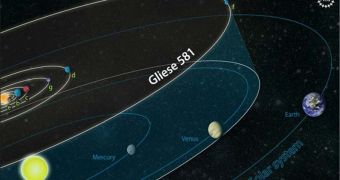Since September, the astronomical community has been buzzing about the exoplanet Gliese 581g, which was found orbiting its parent star in what looked like the habitable zone. Now, experts are starting to argue that another exoplanet in the system, Gliese 581d, may be habitable too.
According to new atmospheric-modeling research, it would appear that this space body is located close enough to its parent star to allow for the presence of liquid water on its surface, yet far enough away to ensure that the liquid doesn't boil and evaporate.
The Gliese 581 star system is now the target of astronomers to both want to prove that Gliese 581g exists, or prove that its doesn't. A heated debate is currently ongoing, and some time is bound to pass until a resolution and a consensus are reached.
“The fact that two models find conditions for liquid water could exist, that strongly implies that it is possible,” explains researcher Philip von Paris.
The scientist, who was the lead author of the new investigation, is based at the Institute for Planetary Research at the German Aerospace Center in Berlin. “It doesn't seem impossible to have life there,” he goes on to say.
Thus far, astronomers were able to observe six planets spinning around the red dwarf Gliese 581, which is located some 20 light-years away from Earth – technically in our backyard.
The latest exoplanet to be discovered, called Gliese 581g, is about three times heavier than Earth, and is believed to be a rocky planet instead of a gas giant. Calculations have placed it right in the middle of its parent star's habitable zone.
All that remains to be done now is demonstrate beyond a reasonable doubt that the planet actually exists, and that it wasn't the result of some calculations or statistical errors, Space reports.
When looking for other potentially habitable planets, experts first turned to Gliese 581g's neighbors. The inner one, called 581c, is now under a powerful greenhouse gas effect, and its surface is most likely scorching hit.
But 581d, 581g's outer neighbor, may be located in just the right spot for a combination of factors to make it habitable. Even if not in its parent star's Goldilocks zone, a greenhouse effect may be warming it to sufficiently high temperatures to allow for liquid water to endure on its surface.
“I found it quite exciting that, even for the 5 percent carbon dioxide atmosphere, we obtained habitable conditions in one case,” von Paris says of 581d.
He and his group conducted atmospheric simulations of the extrasolar planet, in a bid to determine how conditions there might influence the development of life.
The experts tried a variety of chemical combinations, and say that some of them might allow for life to develop at this remote location after all.

 14 DAY TRIAL //
14 DAY TRIAL //